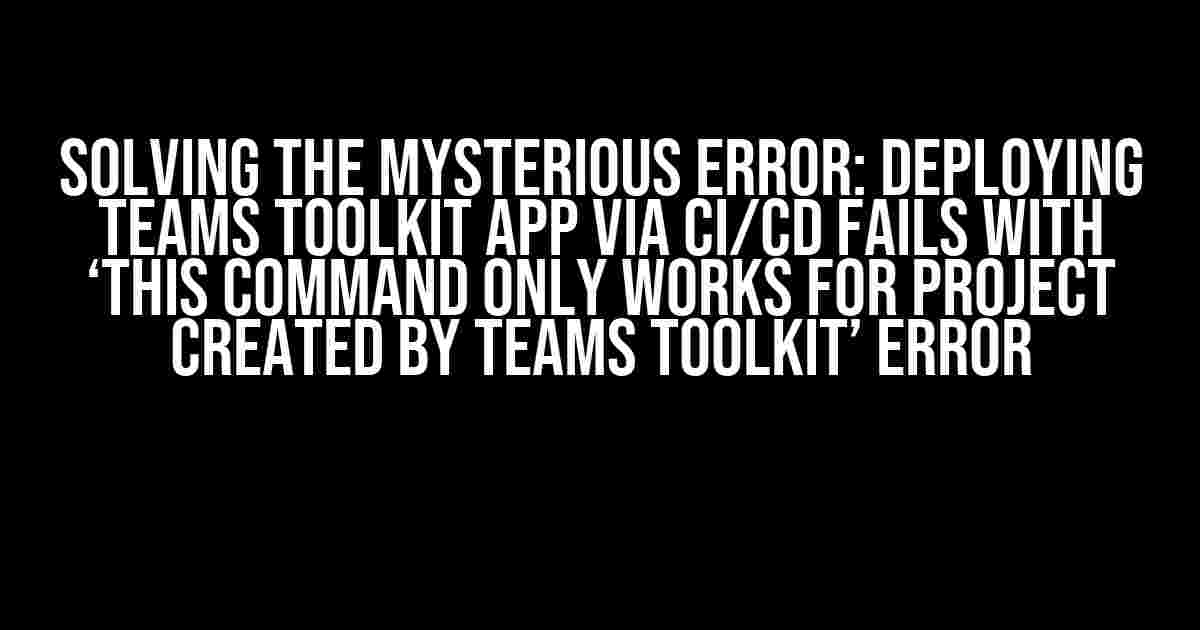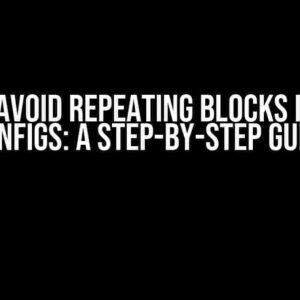Are you tired of banging your head against the wall, trying to figure out why your Teams Toolkit app deployment via CI/CD keeps failing with the infamous ‘This command only works for project created by Teams Toolkit’ error? Well, worry no more! In this comprehensive guide, we’ll delve into the root cause of this issue and provide you with a step-by-step solution to get your deployment up and running smoothly.
Understanding the Error
The ‘This command only works for project created by Teams Toolkit’ error typically occurs when you try to deploy a Teams Toolkit app using a CI/CD pipeline, but the project wasn’t initially created using the Teams Toolkit. This error is often accompanied by a cryptic message that doesn’t provide much context, leaving you wondering what went wrong.
To better understand the error, let’s take a closer look at the Teams Toolkit and how it works. The Teams Toolkit is a set of tools and templates provided by Microsoft to help developers create custom Teams apps more efficiently. When you create a new project using the Teams Toolkit, it generates a specific project structure and configuration files that are tailored to work seamlessly with the toolkit.
The Problem with CI/CD Deployment
When you try to deploy a Teams Toolkit app via CI/CD, the deployment script assumes that the project was created using the Teams Toolkit and expects the specific project structure and configuration files to be present. However, if the project was created manually or using a different toolset, the deployment script will fail, resulting in the ‘This command only works for project created by Teams Toolkit’ error.
Solution: Creating a Compatible Project Structure
To resolve the error, you need to ensure that your project structure and configuration files are compatible with the Teams Toolkit. Here’s a step-by-step guide to help you create a compatible project structure:
-
Create a new folder for your project and navigate to it in your terminal or command prompt.
-
Run the following command to create a new Teams Toolkit project:
teamsfx new myapp. This will create a new project structure with the default configuration files. -
Copy the contents of your existing project into the new project folder, making sure to overwrite any existing files.
-
Update the
manifest.jsonfile to reflect your app’s configuration and settings.
Configuring the Teams Toolkit
To ensure that your project is recognized by the Teams Toolkit, you need to configure the toolkit to point to your project folder. Follow these steps:
-
Open the
teamsfx.jsonfile in your project root and update theprojectPathproperty to point to your project folder. -
Run the following command to initialize the Teams Toolkit:
teamsfx init. This will update the project configuration files to reflect your changes.
Updating the CI/CD Pipeline
Now that you have a compatible project structure and configuration files, you need to update your CI/CD pipeline to deploy your app correctly. Here’s an example of how you can modify your pipeline script:
steps:
- task: TeamsFxInstall@1
displayName: 'Install Teams Toolkit'
inputs:
teamsfxVersion: 'latest'
- task: TeamsFxLogin@1
displayName: 'Login to Teams Toolkit'
inputs:
teamsfxVersion: 'latest'
- task: ArchiveFiles@2
displayName: 'Archive files'
inputs:
rootFolderOrFile: '$(System.DefaultWorkingDirectory)'
includeRootFolder: true
archiveType: 'zip'
archiveFile: '$(Build.ArtifactStagingDirectory)/$(Build.BuildId).zip'
replaceExistingArchive: true
- task: TeamsFxDeploy@1
displayName: 'Deploy to Teams'
inputs:
teamsfxVersion: 'latest'
package: '$(Build.ArtifactStagingDirectory)/$(Build.BuildId).zip'
environment: 'dev'
teamsAppId: '$(TeamsAppId)'
teamsAppPassword: '$(TeamsAppPassword)'
In this example, we’re using the TeamsFxInstall and TeamsFxLogin tasks to set up the Teams Toolkit, followed by the ArchiveFiles task to package the app files. Finally, we’re using the TeamsFxDeploy task to deploy the app to Teams.
Troubleshooting Common Issues
If you’re still encountering issues with your deployment, here are some common pitfalls to watch out for:
-
Incorrect project structure: Make sure your project folder has the correct structure and configuration files.
-
Outdated Teams Toolkit: Ensure that you’re using the latest version of the Teams Toolkit.
-
Invalid manifest.json: Double-check that your manifest.json file is correctly formatted and contains the necessary information.
-
Credential issues: Verify that your Teams app ID and password are correct and properly configured in your CI/CD pipeline.
Conclusion
Deploying a Teams Toolkit app via CI/CD can be a complex process, but by following the steps outlined in this guide, you should be able to overcome the ‘This command only works for project created by Teams Toolkit’ error and successfully deploy your app. Remember to create a compatible project structure, configure the Teams Toolkit, and update your CI/CD pipeline accordingly. With a little patience and perseverance, you’ll be enjoying the benefits of automated deployment in no time!
| Error | Solution |
|---|---|
| ‘This command only works for project created by Teams Toolkit’ | Create a compatible project structure and configure the Teams Toolkit |
| Incorrect project structure | Verify that your project folder has the correct structure and configuration files |
| Outdated Teams Toolkit | Ensure that you’re using the latest version of the Teams Toolkit |
| Invalid manifest.json | Double-check that your manifest.json file is correctly formatted and contains the necessary information |
| Credential issues | Verify that your Teams app ID and password are correct and properly configured in your CI/CD pipeline |
By following these troubleshooting steps, you should be able to identify and resolve common issues that may arise during the deployment process.
Frequently Asked Question
Stuck with the “This command only works for project created by Teams Toolkit” error when deploying Teams Toolkit app via CI/CD? Don’t worry, we’ve got you covered!
What is the main reason behind the “This command only works for project created by Teams Toolkit” error?
The error occurs because the Teams Toolkit app was created outside of the Teams Toolkit environment. The CI/CD pipeline is trying to deploy an app that wasn’t created using the Teams Toolkit, hence the issue.
How do I verify if my project was created using Teams Toolkit?
Check your project’s `config.json` file. If it was created using Teams Toolkit, you’ll see a `manifest` property with a `generatedBy` field containing “Teams Toolkit”.
Can I still use the Teams Toolkit app even if it was created outside of the environment?
Yes, you can! You’ll need to manually create a `config.json` file with the required properties, including the `manifest` property. This will allow you to deploy your app using CI/CD.
What changes do I need to make to my CI/CD pipeline to deploy a Teams Toolkit app successfully?
Update your pipeline to use the Teams Toolkit’s `deploy` command instead of the default `azurePublish` command. This will ensure that the app is deployed correctly.
Where can I find more information on deploying Teams Toolkit apps using CI/CD?
Check out the official Microsoft Teams Toolkit documentation, which provides detailed guides and tutorials on deploying apps using CI/CD pipelines.


